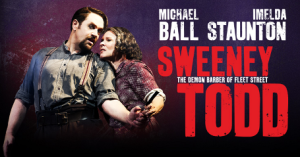There is a revival of Sweeney Todd currently playing London’s West End. If that news alone isn’t enough to get you on the first plane to England, let me explain further: there is a astounding revival of Stephen Sondheim & Hugh Wheeler’s epic Grand Guignol musical currently playing the Adelphi Theatre starring Michael Ball and Imelda Staunton.
Sweeney Todd is in my top three shows of all time; and I’m excited to see any production. And if I could, I would get on the next plane back to London to see this Jonathan Kent directed production again. Dark, unnerving and anchored by two strong central performances, this is a West End revival not to be missed, and a transfer to Broadway should be a no-brainer. The 1979 musical, considered by many (including yours truly), to be Sondheim’s masterpiece tells the story of a vengeful barber who transforms into a blood-thirsty killer, along with his enterprising accomplice and lover, Mrs. Lovett.
Ball is virtually unrecognizable as the deadly barber, both physically and vocally. In fact when he made his first appearance I wasn’t sure whether or not I was seeing an understudy. Admittedly, he wasn’t the draw for me to see the show and my expectations were low but I was more than surprised: Ball is astonishingly good. In the first scenes, we see the “bleeding nobody” brooding with rage, making his mental snap at the end of the first act quite chilling. His “Epiphany” was so intense that for the first time I wasn’t so sure if Mrs. Lovett was going to live to the end of the first act.
Peter Polycarpou plays the Beadle as a social climbing kiss-up rather than some bizarro creep. Peter Howe offers an unsettling portrait of warped piety and deviant sexuality as the Judge. James McConville is absolutely devastating as Toby. Gillian Kirkpatrick scores big as the Beggar Woman. Less effective are Lucy May Barker (think about the name) and Luke Brady as Johanna and Anthony, with lackluster renditions of “Green Finch and Linnet Bird” and “Johanna.”
However, for as good as Ball is in the title role, it is Imelda Staunton who makes this production a must-see. I knew we were in for something different when Staunton whipped out a dirty, empty glass bottle to use as a rolling pin in “The Worst Pies in London.” Her Lovett is unlike any other I’ve ever seen, more naturalistic and pragmatic. She didn’t play up the more comic aspects of the character, but still managed to be funny and find laughs in the most unexpected places. I know the show by heart, and Staunton kept surprising me right to the very end; a performance so indelible I can vividly replay it in my mind. Moments come to mind: her reaction to opening the trunk (which made a delighted audience applaud), the terror on her face during “Epiphany,” the chilling look on her face at the end of “Not While I’m Around,” and the master class of her final scene.
The dynamic between Staunton and Ball was extraordinary, with their scenes together the most memorable. Charged with sexual energy, their showstopping rendition of “A Little Priest” was less music hall romp than full out foreplay. This chemistry makes the finale all the more tragic. When the orchestra played the final chord, I sat there in awe for a good beat before bursting into euphoric applause.
Director Jonathan Kent has set this Sweeney in the 1930s. I’m not sure that the change in time period really adds anything to the piece, but it definitely doesn’t detract. The staging is much more traditional than John Doyle’s recent revival, but I knew as the opening “Ballad” was sung among the characters to each other as working class workplace gossip around London, that we were in for an stellar evening. His production is dark, stark and deliciously violent. Anthony Ward’s set is appropriate dark and eerie, and places the famed factory whistle right on stage. Ward’s costumes evoke the dirt and grime of a seedier side of Fleet Street, and serving the director’s vision quite well.
This production is billed as a strictly limited season, running six months through September 10th. It must be seen to be believed.
A cast album was recorded before performances start and was released in the theatre at or around opening night. Since it wasn’t available anyplace else, I made it a point before seeing the show to pick up a copy. It’s an impressive account of the production, specifically preserving many of Staunton’s finest moments – both spoken and sung. The recording sounds incredible, with some of the show’s sound effects audible (particular the furnace crackling in the final scene, and some truly hair-raising throat slittings). The major flaw is that for some reason the album is one disc. That’s unfortunate, but it doesn’t prevent the album from being a must-have.

